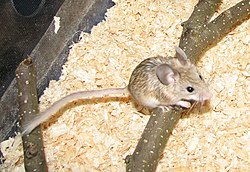Mouse-like hamster
| Mouse-like hamster Temporal range:
| |
|---|---|

| |
| Scientific classification | |
| Domain: | Eukaryota |
| Kingdom: | Animalia |
| Phylum: | Chordata |
| Class: | Mammalia |
| Order: | Rodentia |
| Superfamily: | Muroidea |
| Family: | Calomyscidae Vorontsov & Potapova, 1979 |
| Genus: | Calomyscus Thomas, 1905 |
| Type species | |
| Calomyscus bailwardi Thomas, 1905
| |
| Species | |
|
Calomyscus bailwardi | |


Mouse-like hamsters, also called brush-tailed mice or calomyscids, are a group of small rodents belonging to the genus Calomyscus found in Syria, Azerbaijan, Iran, Turkmenistan, Afghanistan, and Pakistan. They are found in rocky outcrops and semi-mountainous areas in desert regions. The generic name Calomyscus derives from the Greek word kalos, meaning 'beautiful'; the full name translates to "beautiful mouse".[1]
The mouse-like hamsters are not true hamsters, but represent an early split from the rest of the mouse-like rodents. They were once thought to be hamsters based on the shape of their molars, but they lack the cheek pouches, flank glands and short tails of the true hamsters. The closest relatives of the mouse-like hamsters may be the extinct Cricetodontidae.[2] Because of their seemingly early break from the rest of the mouse-like rodents, mouse-like hamsters have been placed in a family of their own, Calomyscidae, and have been referred to as living fossils.[1][3]
All members of the genus were once considered part of the same species, Calomyscus bailwardi, but they are now considered separate species due to major differences in chromosome number, skull measurements, and other features.[4] Several species have been discovered in the 2020s,[5] including Behzad's brush-tailed mouse (C. behzadi)[6] and the Kerman brush-tailed mouse (C. kermanensis).[7] There are two known extinct species: C. delicatus Aguilar et al. 1984 and C. minor de Bruijn et al. 1970.[8]
In Europe, a species of Calomyscus is available as a pet. They are labelled Calomyscus bailwardi mystax or Calomyscus bailwardi. They are generally only available from dedicated breeders, not pet shops.
Species
[edit]The family Calomyscidae consists of eight extant species in one genus. This does not include hybrid species or extinct prehistoric species. Only one of these species, Goodwin's brush-tailed mouse, has more than one subspecies. The cladogram below is based on that produced by Rezazadeh and colleagues in 2024, and excludes Calomyscus tsolovi due to deficient data.[9]
Family Calomyscidae
- Genus Calomyscus: eight species
- Zagros Mountains mouse-like hamster, C. bailwardi
- Baluchi mouse-like hamster, C. baluchi
- Behzad's mouse-like hamster, C. behzadi
- Goodwin's mouse-like hamster, C. elburzensis
- Zykov's mouse-like hamster, C. e. zykovi
- Noble mouse-like hamster, C. grandis
- Hotson's mouse-like hamster, C. hotsoni
- Kerman mouse-like hamster, C. kermanensis
- Great Balkhan mouse-like hamster, C. mystax
- Tsolov's mouse-like hamster, C. tsolovi
- Urar mouse-like hamster, C. urartensis
References
[edit]- ^ a b Musser, G. G.; Carleton, M. D. (2005). "Family Calomyscidae". In Wilson, D. E.; Reeder, D. M. (eds.). Mammal Species of the World: A Taxonomic and Geographic Reference (3rd ed.). Johns Hopkins University Press. pp. 926–930. ISBN 978-0-8018-8221-0. OCLC 62265494.
- ^ Michaux, Johan; Reyes, Aurelio; Catzeflis, François (2001-11-01). "Evolutionary History of the Most Speciose Mammals: Molecular Phylogeny of Muroid Rodents". Molecular Biology and Evolution. 18 (11): 2017–2031. doi:10.1093/oxfordjournals.molbev.a003743. ISSN 0737-4038.
- ^ Jansa, Sharon A.; Weksler, Marcelo (2004). "Phylogeny of muroid rodents: relationships within and among major lineages as determined by IRBP gene sequences". Molecular Phylogenetics and Evolution. 31 (1): 256–276. doi:10.1016/j.ympev.2003.07.002.
- ^ Steppan, Scott J.; Adkins, Ronald M.; Anderson, Joel (2004-08-01). Thorne, Jeff (ed.). "Phylogeny and Divergence-Date Estimates of Rapid Radiations in Muroid Rodents Based on Multiple Nuclear Genes". Systematic Biology. 53 (4): 533–553. doi:10.1080/10635150490468701. ISSN 1076-836X.
- ^ Rezazadeh, Elham; Zali, Hessamodin; Ahmadzadeh, Faraham; Siahsarvie, Roohollah; Kilpatrick, C William; Norris, Ryan W; Aliabadian, Mansour (2024-06-01). "Two new species of brush-tailed mouse, genus Calomyscus (Rodentia: Calomyscidae), from the Iranian Plateau". Journal of Mammalogy. 105 (3): 589–608. doi:10.1093/jmammal/gyad116. ISSN 0022-2372.
- ^ Dezhman, M.; Akbarirad, S.; Aliabadian, M.; Siahsarvie, R.; Shafaeipour, A.; Mirshamsi, O. (2021). "A new species of Calomyscus Thomas, 1905 (Calomyscidae: Rodentia) from western Iran". Turkish Journal of Zoology. 45 (7): 585–593. doi:10.3906/zoo-2101-22.
- ^ Dezhman, M.; Akbarirad, S.; Aliabadian, M.; Siahsarvie, R.; Shafaeipour, A.; Mirshamsi, O. (2023). "A new species of brush-tailed mice of the genus Calomyscus from southern Iran (Calomyscidae: Rodentia)". Iranian Journal of Animal Biosystematics. 19 (1): 71–101. doi:10.22067/IJAB.2023.79456.1045.
- ^ "Fossilworks: Calomyscidae". Paleobiology Database. University of Wisconsin–Madison. Retrieved June 11, 2025.
- ^ Rezazadeh, Elham; Zali, Hessamodin; Ahmadzadeh, Faraham; Siahsarvie, Roohollah; Kilpatrick, C William; Norris, Ryan W; Aliabadian, Mansour (2024-06-01). "Two new species of brush-tailed mouse, genus Calomyscus (Rodentia: Calomyscidae), from the Iranian Plateau". Journal of Mammalogy. 105 (3): 589–608. doi:10.1093/jmammal/gyad116. ISSN 0022-2372.








